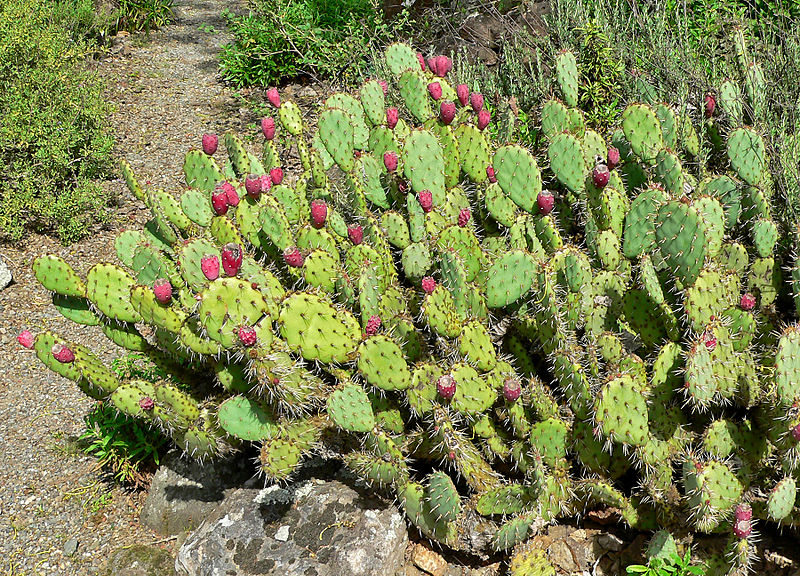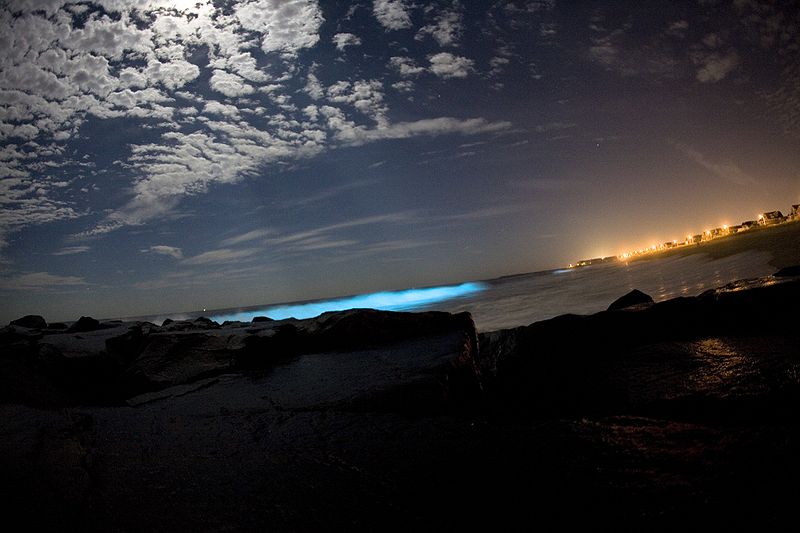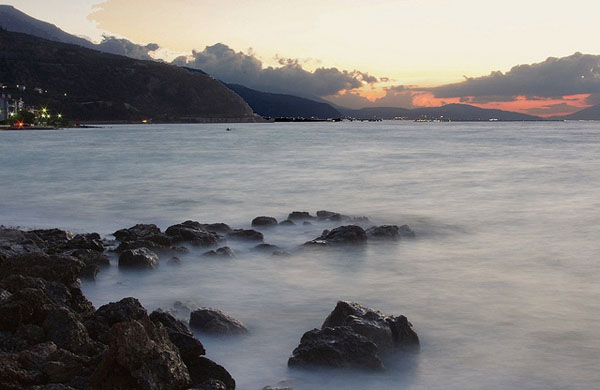Life in the Neighborhood
Interactions
 Like all other organisms on Earth, Pyrocystis fusiformis
needs to eat. It does this through the process of photosynthesis
(Miller 2010).
Photosynthesis involves using energy from light
photons to drive the production of sugars from CO2. This process
takes place in the plastids (such as chloroplasts) within the
cell. However, photosynthesis is not the only way P. fusiformis
obtains its food. It can also feed on other planktonic species
in its habitat. Because it can act as both an autotroph (making
its own food) and heterotroph (eating other organisms for food),
it is called a mixotroph (Miller 2010). An example of a
heterotroph is the
American Crocodile, and an example of an autotroph would be
Pancake Prickly Pear Cactus.
Like all other organisms on Earth, Pyrocystis fusiformis
needs to eat. It does this through the process of photosynthesis
(Miller 2010).
Photosynthesis involves using energy from light
photons to drive the production of sugars from CO2. This process
takes place in the plastids (such as chloroplasts) within the
cell. However, photosynthesis is not the only way P. fusiformis
obtains its food. It can also feed on other planktonic species
in its habitat. Because it can act as both an autotroph (making
its own food) and heterotroph (eating other organisms for food),
it is called a mixotroph (Miller 2010). An example of a
heterotroph is the
American Crocodile, and an example of an autotroph would be
Pancake Prickly Pear Cactus.
 Not only does P. fusiformis eat, but it also gets eaten. It
is an important food source for common marine organisms such as
fish like the
Atlantic Cod, baleen whales, and whale sharks, who obtain their food
through filter-feeding (Miller 2010).
Not only does P. fusiformis eat, but it also gets eaten. It
is an important food source for common marine organisms such as
fish like the
Atlantic Cod, baleen whales, and whale sharks, who obtain their food
through filter-feeding (Miller 2010).
The marine food web has an important place for P. fusiformis. As a phytoplankton, it is an essential producer in the world’s oceans by contributing to the total oxygen concentration. P. fusiformis also serves as a food source for other marine organisms, which helps maintain stability and diversity in the food web (Miller 2010).
An Oceanic Burglar Alarm
Pyrocystis fusiformis has an interesting way of deterring predators. It employs what is sometimes called the “Burglar Alarm Theory” (Fleisher and Case 1995). When in the presence of a predator, P. fusiformis becomes bioluminescent. The light it releases acts as a kind of burglar alarm, alerting other organisms of its location. These other organisms will then eat P. fusiformis’ predators. P. fusiformis does this in the hope that its predators will be attacked before it is attacked, much like a burglar alarm alerts authorities to the location of the burglar. This takes the pressure off of P. fusiformis and places it upon its predators instead (Fleisher and Case 1995). Because P. fusiformis tends to congregate in large groups, this strategy benefits the species overall (Miller 2010). Without this strategy, P. fusiformis’ predators would not be threatened and could potentially feed on the entire group of P. fusiformis. This strategy increases the chance that predators of P. fusiformis will be killed and eaten by other organisms, protecting the overall group of P. fusiformis at the expense of a few individuals. Overall, the luminescent genotype is favored (Miller 2010).
 The light emitted from bioluminescent dinoflagellates such as
Pyrocystis fusiformis not only serves to protect itself, but it
also impacts the feeding efficiency of larger, predatory
organisms that do not feed on P. fusiformis. The light produced
by P. fusiformis acts as a kind of flashlight or searchlight by
which predatory organisms such as fish and cephalopods can find
and feed on other, non-bioluminescent organisms. Without this
light, the predation success of the fish and cephalopods is
greatly reduced. In contrast, as the amount of bioluminescent P.
fusiformis organisms increases, predation on other
non-luminescent prey increases (Fleisher and Case 1995). This
makes sense because the more numbers of P. fusiformis present,
the more light is produced, and the better predators can locate
prey.
The light emitted from bioluminescent dinoflagellates such as
Pyrocystis fusiformis not only serves to protect itself, but it
also impacts the feeding efficiency of larger, predatory
organisms that do not feed on P. fusiformis. The light produced
by P. fusiformis acts as a kind of flashlight or searchlight by
which predatory organisms such as fish and cephalopods can find
and feed on other, non-bioluminescent organisms. Without this
light, the predation success of the fish and cephalopods is
greatly reduced. In contrast, as the amount of bioluminescent P.
fusiformis organisms increases, predation on other
non-luminescent prey increases (Fleisher and Case 1995). This
makes sense because the more numbers of P. fusiformis present,
the more light is produced, and the better predators can locate
prey.
You may or may not have heard of what is called the Milky
Seas Phenomenon. This understudied event that occurs in the
oceans results in a milky white glow on the surface of the
water, sometimes for days and over many miles. Originally,
scientists thought P. fusiformis was the cause of this milky
glow, since it congregates in groups and has the ability to
bioluminesce. However, this idea was disputed when it was
 realized that
P. fusiformis emits flashes of light and not a
steady glow. It is now believed that the bioluminescent bacteria
Vibrio harveyi is at the root of this spectacle. V. harveyi is
capable of producing an extended bioluminescent glow and lives
on algal blooms on the water’s surface, so it is a likely
candidate for causing Milky Seas. The broader implications and
environmental impacts of Milky Seas have not yet been determined
(Miller 2010).
realized that
P. fusiformis emits flashes of light and not a
steady glow. It is now believed that the bioluminescent bacteria
Vibrio harveyi is at the root of this spectacle. V. harveyi is
capable of producing an extended bioluminescent glow and lives
on algal blooms on the water’s surface, so it is a likely
candidate for causing Milky Seas. The broader implications and
environmental impacts of Milky Seas have not yet been determined
(Miller 2010).
Pyrocystis fusiformis impacts other marine organisms as well as impacting humans. Humans find P. fusiformis useful in conducting bioassays. For example, it can be used in experiments to assess chemical contamination in certain areas. P. fusiformis is inexpensive and relatively easy to obtain and maintain compared to other, larger organisms, which makes it an ideal organism to use in such toxicity studies (Miller 2010). In addition, since P. fusiformis is a phytoplankton, it increases the oxygen concentration in the atmosphere. Humans and many other organisms require oxygen to live, and much of this oxygen is due to oceanic phytoplankton such as P. fusiformis. It also helps keep the marine food web stable by providing a food source to other organisms; humans in turn can use these organisms as a food source for themselves.
While Pyrocystis fusiformis may be small and relatively unknown to the general human population, it has an important part to play in the world’s ecosystem.
"Leave me alone, eat that other guy!"
-Pyrocystis fusiformis
Want to know more interesting facts about Pyrocystis fusiformis? Go to Fun Facts.
To continue your discovery of various organisms, you can visit other webpages created by Organismal Biology students at MultipleOrganisms.net.
To visit UW-La Crosse's website,
click here.